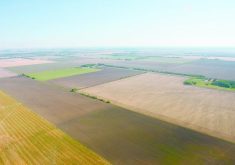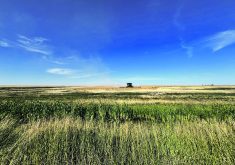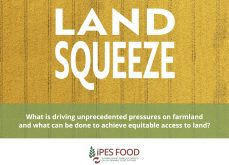Canadian farmland values continued to climb during the first half of 2020, according to an interim valuation review by agricultural lender Farm Credit Canada.
But the appreciation rate is not as rapid as it was a few years ago.
Across Canada, farmland values rose on average by 3.7 percent during the first six months of 2020, the FCC review said.
By province, the largest value increases occurred in New Brunswick (up 6.5 percent), Alberta (up 4.9 percent) and Saskatchewan up (4.2 percent). Manitoba farmland values rose by 2.3 percent, the review stated.
Farmland values in all but three Canadian provinces increased by less than the national average of 3.7 percent, FCC said.
The valuation review, released last month, covered farmland values for the six-month period ending Jun 30, 2020.
Cathy Gale, FCC’s director of valuations for Western Canada, said a number of factors influenced farmland values in Western Canada in early 2020, including low interest rates and reasonably good prices for a number of commonly produced farm commodities.
The global pandemic does not appear to have dampened demand for farmland in Western Canada, she added.
Conversely, the COVID-19 pandemic has supported prices for many commodities grown in Western Canada.
Across Canada, crop receipts for the first six months of 2020, excluding cannabis, were 1.6 percent higher than they were for the same period in 2019, FCC said.
“There still seems to be good demand for farmland in all the prairie provinces,” Gale said.
“There’s still strong demand for food. Through this whole (pandemic) people have been buying groceries… so there’s still strong demand for the commodities, commodity prices are decent and interest rates are at rock bottom, as low as they can possibly be. People are saying: you know what? Land is still a good investment.”
Read Also

Farming Smarter receives financial boost from Alberta government for potato research
Farming Smarter near Lethbridge got a boost to its research equipment, thanks to the Alberta government’s increase in funding for research associations.
Over the five-year period ending Dec 31, 2019, Canadian farmland values have increased on average by slightly more 7.6 percent per year, FCC data said.
During the previous five-year period (Jan. 1, 2010 to Dec 31, 2014), farmland values across the country increased by an average of more than 15 percent per year.
In early 2020, FCC did not see the “huge increases” that were the norm a few years ago, Gale said. “But we still saw increases.”
According to FCC, average farmland values have increased every year since 1993. Increases were more pronounced from 2011 to 2015.
In 2013, for example, farmland values rose by more than 22 percent across Canada and by an estimated 28.5 percent in Saskatchewan.
Since 2016, Canada on-average has seen more moderate single-digit increases in average farmland values.
Despite the more modest increases recorded in early 2020, Canadian farmland continues to be viewed by farmers as a sound investment.
In the West, many land transactions are the result of farm expansions and farm transition plans that involve younger farmers taking over from older generations.
FCC’s chief agricultural economist J.P. Gervais described the Canadian market for farmland as resilient.
“Given the global economic situation during the first half of 2020, Canada’s farmland market is showing remarkable resilience in the face of adversity and uncertain times,” Gervais said.
“Changes to production and marketing plans induced by the pandemic have had a definite influence on profitability, yet the demand for farmland remained robust.”
Despite supply chain disruptions that have impacted some sectors, such as red meat, the pandemic has not significantly affected the agriculture land market, Gervais said.
“In fact, the grain, oilseed and pulse sectors have performed well in the first half of 2020, supporting the slightly higher rate of increase in Western Canada.”
Gervais recommended that farm operators continue to exercise caution, especially in regions where the growth rate of farmland values significantly exceeded that of farm income in recent years.



















